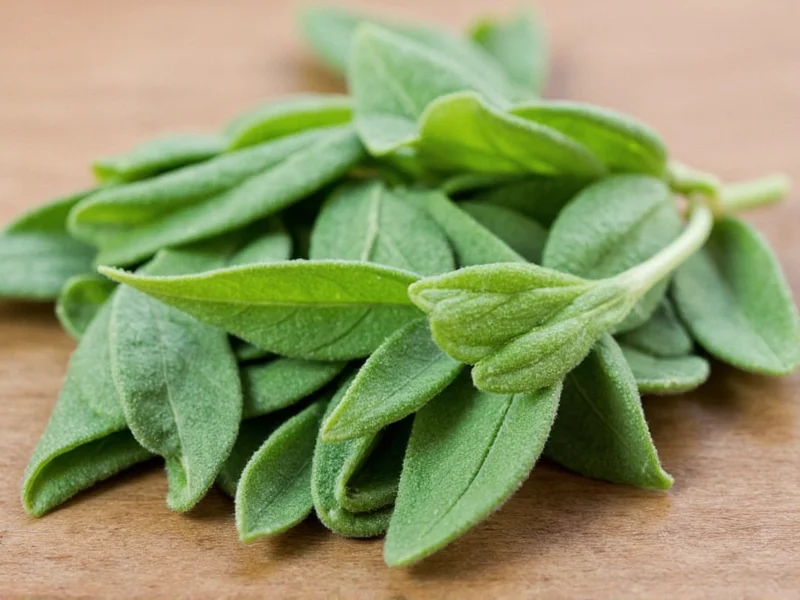1 tablespoon of fresh sage equals 1 teaspoon of dried sage. This 3:1 conversion ratio accounts for dried sage's concentrated flavor due to moisture loss during the drying process. Always adjust slightly based on recipe requirements and personal taste preferences.
Understanding Fresh to Dried Sage Conversion
When adapting recipes, knowing the precise conversion between fresh and dried sage is essential for balanced flavor. The standard culinary guideline states that 1 tablespoon of fresh sage equals 1 teaspoon of dried sage. This 3:1 ratio exists because the drying process removes moisture, concentrating the herb's essential oils and flavor compounds.
Professional chefs and experienced home cooks rely on this conversion when substituting between fresh and dried sage. Understanding this measurement conversion prevents overpowering dishes with sage's distinctive earthy, slightly peppery flavor. Getting this ratio wrong can dramatically alter your recipe's outcome, making this knowledge crucial for consistent cooking results.
The Science Behind Herb Conversion Ratios
Herb conversion ratios aren't arbitrary—they're based on scientific principles of moisture content and flavor concentration. Fresh sage contains approximately 80-85% water, while dried sage has only about 5-10% moisture. This significant water reduction means dried sage delivers more concentrated flavor in a smaller volume.
The essential oils responsible for sage's distinctive aroma and taste become more potent as water evaporates during drying. This concentration effect explains why you need less dried sage than fresh to achieve equivalent flavor impact in your dishes. However, dried herbs lack some of the bright, grassy notes found in fresh varieties, which is why many chefs prefer fresh when available.
Complete Sage Measurement Conversion Guide
| Measurement | Fresh Sage | Dried Sage |
|---|---|---|
| Teaspoon | 3 tsp | 1 tsp |
| Tablespoon | 1 tbsp | 1 tsp |
| ¼ Cup | ¼ cup | 1½ tbsp |
| ½ Cup | ½ cup | 3 tbsp |
| 1 Cup | 1 cup | ⅓ cup |
When to Adjust the Standard Conversion Ratio
While the 3:1 fresh-to-dried ratio serves as a reliable starting point for how much dried sage equals fresh sage, certain factors may require slight adjustments:
- Recipe cooking time: For dishes simmering longer than 30 minutes, reduce dried sage by 25% as flavors intensify during prolonged cooking
- Herb quality: Older dried sage loses potency—use 25% more if your dried sage is over a year old
- Dish acidity: Acidic ingredients like tomatoes or vinegar can mellow sage's flavor—consider increasing by 10-15%
- Personal preference: If you prefer more subtle herb notes, start with 25% less dried sage than the conversion suggests
Practical Cooking Applications
Understanding the fresh sage to dried conversion becomes particularly valuable when preparing traditional dishes where sage plays a starring role:
For Italian brown butter sage pasta, the fresh herb's bright flavor shines when added at the end of cooking. When substituting dried sage, add it earlier in the cooking process to allow time for rehydration and flavor release. In poultry seasoning blends, dried sage works perfectly as its concentrated flavor penetrates meat effectively during roasting.
When making sage tea, fresh leaves provide a more delicate flavor profile, while dried sage offers stronger medicinal properties. For stuffing recipes, many chefs recommend using a combination of both forms—dried for base flavor and fresh for finishing—to achieve complex flavor层次.
Common Substitution Mistakes to Avoid
Even experienced cooks sometimes make errors when converting between fresh and dried sage. The most frequent mistakes include:
- Using equal volumes (1:1 ratio) instead of the proper 3:1 conversion
- Adding dried sage at the same stage as fresh in recipes without adjusting timing
- Not properly storing dried sage, leading to diminished potency and inaccurate conversions
- Assuming all herbs share identical conversion ratios (sage's ratio differs slightly from herbs like thyme or rosemary)
Remember that dried sage requires time to rehydrate and release its full flavor. Always add it earlier in the cooking process than fresh sage, typically when sautéing aromatics. For cold applications like salad dressings, steep dried sage in warm oil first to activate its flavor compounds before incorporating into the recipe.
Storing Sage for Optimal Flavor
Proper storage affects conversion accuracy. Fresh sage keeps for 7-10 days when wrapped in a slightly damp paper towel inside a perforated plastic bag in the refrigerator. Dried sage maintains peak potency for 6-12 months when stored in an airtight container away from light and heat.
Test your dried sage's freshness by rubbing a pinch between your fingers—if it doesn't release a strong aroma, it's lost potency and you'll need to use more than the standard conversion suggests. Fresh sage should have a vibrant green color and springy texture; wilted or yellowing leaves indicate diminished flavor strength.











 浙公网安备
33010002000092号
浙公网安备
33010002000092号 浙B2-20120091-4
浙B2-20120091-4